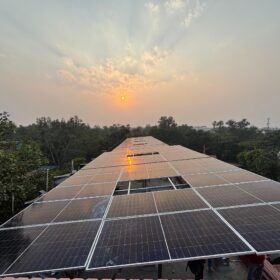From pv magazine November edition
It must have been a delight for Daniel Brandl to win this commission. He is known in the industry for his advocacy of electromobility in combination with large commercial PV installations. Through his company Orange Solar, he was selected to participate in Germany’s largest electric charging station to date: the new multi-story parking garage of IT system service provider Bechtle. The garage has 1,586 parking spaces over 40,000 square meters. A total of 50 parking spaces are electrified, so that when there is enough sunshine the batteries are charged with green solar power.
It is tempting to see this as a ‘glass half-empty’ scenario, since only 3% of the parking spaces are electric, but it is more like half full. Even though electromobility is only slowly gathering momentum, reports of new projects in which cars are not only charging, but charging with green power, are now coming on a weekly basis. There is no single application or business model here though – electric vehicle charging has many facets.
One of these is that the industry is planning for the future. “The 50 charging stations for e-mobility that we are providing in the multi-story parking garage serve the need for charging facilities that we expect to develop in the coming years. They are also an important component in the implementation of the e-mobility/hybrid strategy for our fleet,” says Bechtle spokesperson Rainer Kury.
Like many others, Brandl is convinced that e-mobility will rapidly increase the demand for electricity in the near future. “This is a good reason for commercial enterprises not to design the plants too small, and to fill up their roofs now,” he says. On the Bechtle multi-story parking garage, his company installed a new photovoltaic system with a capacity of almost 750 kW, and integrated an existing
600 kW system into the overall concept.
That is enough for 450 electric cars to run purely on solar electricity. Brandl is particularly enthusiastic about load management in the Bechtle multi-story parking garage – this makes it possible to control the charging of cars based on solar power generation. The solar power is used directly for the 50 charging stations, as well as for a number of technical facilities, Kury explains. Bechtle currently has 90 electric and hybrid vehicles in its fleet of company cars. That is 4%, and this share is set to rise to 10% by the end of 2019.
Bechtle has therefore set up the charging points with a view to its own fleet. The same applies to the outpatient nursing service in Nördlingen-Herkheim, with one key difference: Not only is the electricity generated partly by solar panels, but the solar power is also stored. Johannes Beck, Managing Director of Diakonie Donau-Ries, which owns the nursing service, began electrifying its car fleet a year ago. Currently, a sixth electric vehicle is being added to the total fleet of 22 cars, he says.
Solar modules are installed on two thirds of the roof of the main building facing south, and on the carport facing east-west. The plant has a total capacity of 28.5 kW. In addition, there is a commercial energy storage facility from Varta Storage with an output of 36 kW and a capacity of 75 kWh.
Since June, the electric cars have been refueled entirely with solar power, either directly or from the battery. “In this sunny summer, the self-sufficiency rate was almost 100% – over the year as a whole we expect a rate of around 40%,” says Reiko Stutz, General Manager Commercial Storage Solutions at Varta Storage.
What makes Diakonie so ideal for this business model are the daily routes and the distribution of trips between morning and evening. Beck explains that there are 30 rounds a day, and that the vehicles return in the middle of the day, which makes recharging during the PV production peaks easy. After use on the evening rounds, solar power from the storage system is ideally available again for slow recharging. Beck emphasizes that the electric cars are used especially for the longer trips of around 90 kilometers.
Storage can also buffer peak loads
Reiko Stutz expects such new energy concepts to further increase the demand for commercial storage facilities. After all, these were not only used to increase the amount of solar power generated on-site for refueling electric vehicles. They are also well suited to buffering generation peaks. “The connected load in commercial operations can reach its limits if several electric cars are charged simultaneously,” says Varta Storage’s Managing Director. In this case, the commercial storage system can take over and buffer the peak power in order to avoid increased service charges or investments in heavier power cables for the company.
In Germany, many projects that make green charging possible are initiated primarily by progressive commercial enterprises that could be described as early adopters. Another project, located on the Portuguese island of Porto Santo goes beyond that. It is virtually impossible to travel long distances there, which is why the island is suitable for testing innovative concepts that combine electromobility with renewable energies and storage facilities. The popular holiday destination, part of the Madeira archipelago, is 11 kilometers long and no more than six kilometers wide. During peak season there are 20,000 people romping around on the island, which has only about 5,000 permanent inhabitants and whose energy in the past was supplied by diesel generators.
The Mobility House launched the “Smart Fossil Free Island” project in February with Renault and Madeira EEM’s energy supplier that is designed to change this situation radically. The four cornerstones of the concept are electric vehicles, stationary energy storage, smart charging and discharging, and vehicle-to-grid applications, explains Managing Director Thomas Raffeiner. The first stage of the project has already been completed. There is a 2 MW PV plant and 1.1 MW of wind turbines. This is complemented by a
132 kW/121 kWh stationary storage system, as well as 40 vehicle charging stations.
Over the next three years, the car fleet will be completely converted to electric vehicles. This will total some 1,000 vehicles. The infrastructure also has to be adapted accordingly. The Mobility House plans to install a total of 200 unidirectional and 450 bidirectional charging stations on the island by 2022. The unidirectional chargers will be operated exclusively with renewable electricity. The storage capacity will be expanded to 9.5 MW by then, with second life batteries from Renault and other electric vehicles being integrated into the system, Raffeiner adds.
The islanders can hope for a nice side effect to the conversion. “We plan to make the electric vehicles available to the inhabitants free of charge,” says Raffeiner. This would also be worthwhile for the companies because it creates more flexibility in the form of rolling power storage.
Solar power in the tank pays off
All of these projects raise the question of profitability. Daniel Brandl calculates that at €0.05/kWh, the production cost for the solar electricity from the large roof-mounted system, and €0.277/kWh for the proportionate EEG levy for on-site consumption add up to a net cost of around €1.60 per 100 kilometers on average for the charging of an electric car. Compared with a commercial electricity tariff of around €0.18/kWh, the commercial power is more than twice as much, at €3.60. The potential is even greater when compared with the cost of gasoline engines, which have a refueling cost of some €8.10 per 100 kilometers. However, if you feed in for €0.10/kWh and buy back the charging current for €0.18/kWh, you cannot really win by consuming it yourself. Thus, the business model depends on a number of variables.
Diakonie compared the investments in electric vehicles, photovoltaics, and storage with the purchase of a Fiat Panda. According to Beck, with annual trips totaling 34,000 kilometers the operation will break even after four years, if it primarily uses its own solar power. If the electric car was only used for 15,000 kilometers, it would take five years. According to Beck, the industrial storage system has only a marginal effect on the payback period. However, the bill also includes government subsidies for four electric vehicles. The saved trips to the filling station also had a positive effect, which Beck estimates at an additional €1,000 per vehicle.
Obstacles to the operation of public charging points
Most of these projects target commercial fleets, but what about the economics of public solar-powered charging stations? At the “green charging station” in Chemnitz, drivers can now fill their electric cars with clean electricity around the clock. As long as the sun is shining, the installed PV system delivers 40 kW of electricity, and the rest is certified green electricity, as Managing Director Klaus Hoffmann of Heos explains. The linking of charging stations with renewable energy is essential for Hoffmann and a component of all of the “Green Pillars” that Heos is currently setting up in cooperation with the Chemnitz Development Community (Chemnitzer Siedlungsgemeinschaft eG).
Despite his commitment, Hoffmann says, “Unfortunately, nobody in Germany today can operate a public e-charging station at a cost-covering level.” In addition to general prejudices against electromobility, he sees other obstacles that currently hamper the economic viability of public charging stations: “The current calibration law and the price surcharge regulation on electricity sales significantly increase the blood pressure of every charging station operator.” With regard to the integration of storage facilities into the concepts, he sees technical and financial hurdles as well as legal obstacles, since this would no longer involve direct internal consumption and would lead to further disadvantages in the taxation of the electricity.
Brandl points to a legal obstacle that, in his view, makes the spread of electromobility more difficult. Until the end of 2020, for example, there will be a temporary arrangement in Germany under which employers are permitted to allow their employees to charge their electric vehicles, and are not required to tax it as a non-cash benefit. “It is quite conceivable that this regulation will be extended beyond 2020. But it is risky for small companies to set up a business model on the basis of a temporary transitional arrangement,” he says, considering that the purchase of a charging station only pays for itself after about five years.
The chicken-and-egg problem
The public charging station segment is likely to suffer most from the chicken-and-egg problem. The number of new registrations for electric cars in Germany has been stagnating at around 1% for several years. So there simply will not be enough electric vehicles for investors to invest in charging points.
Hans Urban, who is active as a consultant for Schletter, MaxSolar, and Smart Power among others, sees an onus on the automakers. “The availability of electric vehicles is the biggest problem at the moment,” he says.
“If we achieve a new registration rate of 5-10% for electric vehicles, these business models will gain importance,” says Orange Solar Managing Director Brandl. Raffeiner is optimistic and believes that the availability of electric cars will noticeably improve over the next two years.
The Mobility House is already planning further projects in Germany. Raffeiner says that talks are currently underway with operators of bus depots, delivery services, and logistics companies, among others, although he did not want to name potential customers. The technical concepts already exist, and the system concept set up in Porto Santo could also be transferred to other areas such as airports, hotels, military bases, and football stadiums.
For public charging stations, improved economic efficiency is definitely within reach, simply by combining them with solar power generation. “I see the use of PV electricity generated by the company itself as a great opportunity to significantly reduce power generation costs at the charging station, and at the same time make an environmental contribution and establish a viable operator model in the future,” says Hoffmann. An exemption from the EEG surcharge for on-site consumption would further accelerate the whole process.
This content is protected by copyright and may not be reused. If you want to cooperate with us and would like to reuse some of our content, please contact: editors@pv-magazine.com.









1 comment
By submitting this form you agree to pv magazine using your data for the purposes of publishing your comment.
Your personal data will only be disclosed or otherwise transmitted to third parties for the purposes of spam filtering or if this is necessary for technical maintenance of the website. Any other transfer to third parties will not take place unless this is justified on the basis of applicable data protection regulations or if pv magazine is legally obliged to do so.
You may revoke this consent at any time with effect for the future, in which case your personal data will be deleted immediately. Otherwise, your data will be deleted if pv magazine has processed your request or the purpose of data storage is fulfilled.
Further information on data privacy can be found in our Data Protection Policy.